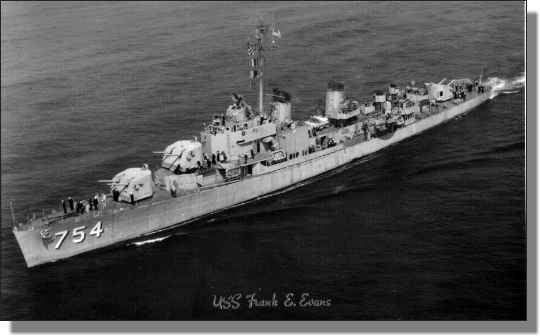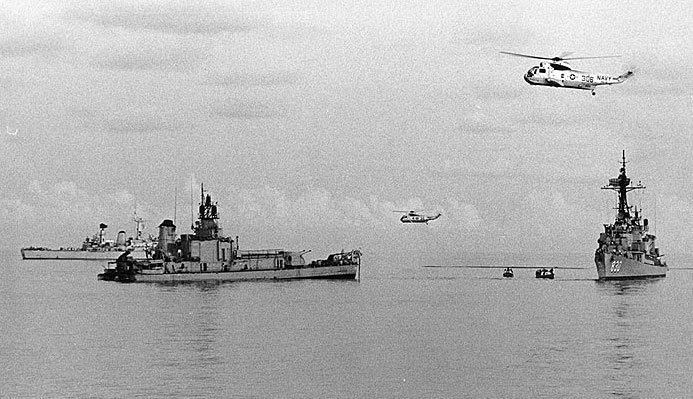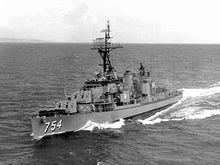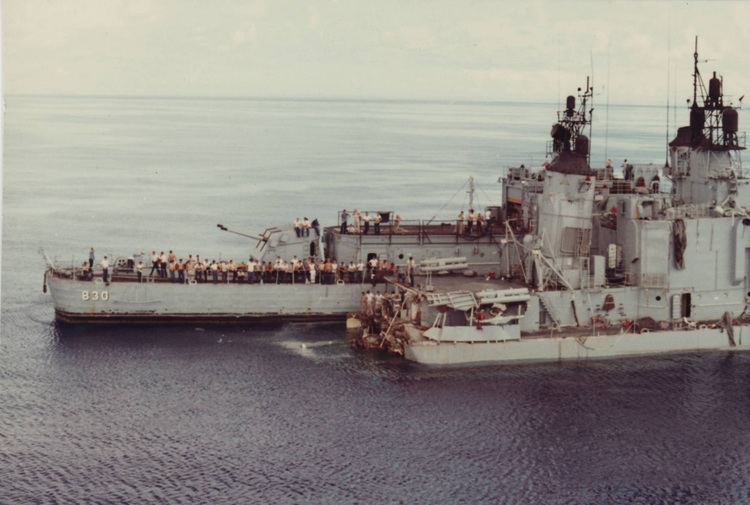Name USS Frank E. Evans Commissioned 3 February 1945 Construction started 21 April 1944 Length 115 m | Laid down 21 April 1944 Struck 1 July 1969 Launched 3 October 1944 Builder Bethlehem Mariners Harbor | |
 | ||
Namesake Brigadier General Frank Evans Nickname(s) "Gray Ghost"
"Lucky Evans" | ||
I relieve you sir 1975 training film about the uss frank e evans dd754 collision
USS Frank E. Evans (DD-754), an Allen M. Sumner-class destroyer, was named in honor of General Frank Evans, a leader of the American Expeditionary Force in France during World War I. She served in late World War II and the Korean War, and Vietnam War before being cut in half in a collision with HMAS Melbourne in 1969.
Contents
- I relieve you sir 1975 training film about the uss frank e evans dd754 collision
- Construction
- World War II
- Korean War
- Vietnam
- Collision with HMAS Melbourne
- Awards
- References

Construction

Her keel was laid down at the Bethlehem Steel Company shipyard in Staten Island, New York. She was launched on 3 October 1944 sponsored by Mrs. Frank E. Evans, widow of General Evans, and commissioned on 3 February 1945, with Commander Harry Smith in command.
World War II

Frank E. Evans arrived at Pearl Harbor on 18 May 1945 for her final training, and crossed to Eniwetok, Guam, Ulithi, and Okinawa on escort duty. Reaching action waters on 24 June, she was assigned to radar picket and local escort duty, often firing on enemy aircraft. At the close of hostilities, she patrolled the Yellow Sea and the Gulf of Chihli, embarked released Americans from prisoner of war camps near Dairen, Manchuria, covered occupation landings at Jinsen, Korea, and continued to operate in the Far East until 6 March 1946 when she sailed from Tsingtao for San Francisco, California. Immobilized there on 31 March, Evans was decommissioned and placed in reserve on 14 December 1949.
Korean War

Recommissioned on 15 September 1950 for duty in the Korean War, Evans sailed from San Diego, California on 2 January 1951 for duty with the 7th Fleet. On 26 February, she began her part in the lengthy siege of Wonsan, during which she engaged enemy shore batteries 11 times. On 18 June, she was struck by 30 shrapnel hits, which caused minor wounds to four crewmembers before the destroyer silenced the enemy battery. It was during this time that Frank E. Evans earned the nicknames "Lucky Evans" and the "Gray Ghost".

During this tour of duty, Evans also bombarded targets in the Songjin-Chongjin area, rescued downed aviators, and coordinated and controlled day and night bombing missions by United Nations aircraft. She returned to San Diego on 4 September 1951.
Evans sailed on 22 March 1952 for her second Korean tour, serving on patrol and bombardment duty along the coast of Korea and on the Taiwan Patrol before returning to her new home port, Long Beach, California, on 6 November 1952 for three months. Her tour in the Far East from 13 June to 20 December 1953 coincided with the Korean armistice, and was devoted primarily to patrol duty.
While riding out Typhoon Pamela in the Taiwan Straits in early November 1954, Frank E. Evans responded to an SOS by USNS Muskingum, which had lost steering control near the center of the storm. Frank E. Evans had escaped to the edge of the typhoon, but turned back into the storm racing for five hours to render assistance while taking damage in the process. In the end, Muskingum was able to regain control before Frank E. Evans arrived, but the incident was widely publicized in newspaper syndication because Pulitzer prize winning correspondent Homer Bigart was reporting from Frank E. Evans during that period.
From 1954 to 1960, Evans completed five tours of duty in the Far East, as well as joining extensive training operations along the west coast and in the Hawaiian Islands, occasionally with Canadian naval ships.
From 1962 to 1963, the ship was the fictitious Appleby used in the NBC military comedy series Ensign O'Toole starring Dean Jones in the title role.
Vietnam
According to the US Navy Awards file, Frank E. Evans served in the waters off Vietnam for 12 days from July to September 1965. Evans was again in the vicinity of Vietnam for 61 days from August to November 1966. Evans returned to Vietnam and served there for 66 days from October 1967 to 20 February 1968. During the Tet Offensive, on 3 February 1968, Frank E. Evans provided naval gunfire support to the 101st Airborne Division near Phan Thiết against the 840th VC Battalion. Evans also spent an additional 14 days in 1969 in the Vietnam war zone.
Collision with HMAS Melbourne
At around 3 a.m. on 3 June 1969, between Vietnam and Spratly Island, Frank E. Evans was operating with the Royal Navy, Royal Australian Navy and Royal New Zealand Navy in company with Melbourne which was in the process of going to flying stations and all ships in the formation were running without lights. Melbourne radioed Evans, then to port of the carrier, to take up the rescue destroyer position. The logical movement would be to turn to port and make a circle taking up station on the carrier's port quarter. However, since the conning officer on Evans misunderstood the formation's base course and believed they were starboard of Melbourne, they turned to starboard, cutting across the carrier's bow twice in the process. Frank E. Evans was struck at a point around 92 feet from her bow on her port side and was cut in two. Her bow drifted off to the port side of Melbourne and sank in less than five minutes taking 73 of her crew with it. One body was recovered from the water, making a total of 74 dead. The stern scraped along the starboard side of Melbourne and lines were able to be attached by the crew of Melbourne. Around 60-100 men were also rescued from the water.
At the time of the collision the commanding officer of Frank E. Evans was asleep in his quarters having left instructions to be awakened if there were to be any changes in the formation. Neither the officer of the deck nor the junior officer of the deck notified him when the station change was ordered. The bridge crew also did not contact the combat information center to request clarification of the positions and movements of the surrounding ships. The collision occurred at 8°59.2′N 110°47.7′E.
USS Frank E. Evans was decommissioned at Subic Bay and stricken from the Naval Vessel Register on 1 July 1969. The stern section was sunk as a target in Subic Bay on 10 October 1969.
Awards
Frank E. Evans received one battle star for World War II service, and five for Korean war service. According to the US Navy unit award website, Frank E. Evans had the following awards:
